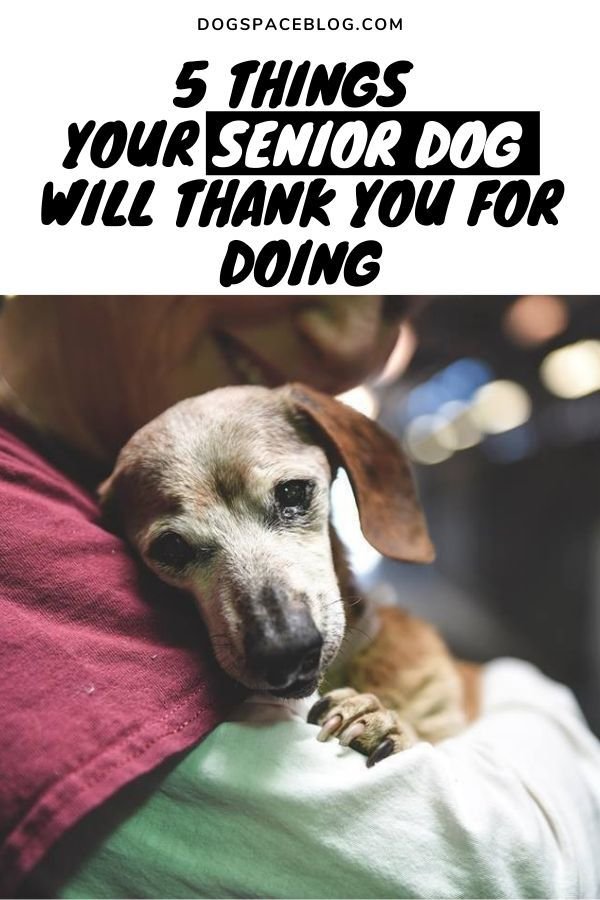Senior dogs will thank you for keeping them active, providing mental stimulation, giving them quality time, taking care of their physical health, and showing them love and affection. As our furry friends age, they still have a strong desire to engage with the world around them and maintain their overall well-being.
By incorporating these five simple actions into our daily routines, we can ensure that our senior dogs feel happy, loved, and appreciated. From gentle exercise and playtime to challenging their minds through interactive toys and puzzles, there are plenty of ways to keep our senior dogs physically and mentally sharp.
Additionally, regular check-ups with the vet, a nutritious diet that meets their specific needs, and regular grooming sessions help to maintain their overall health and well-being. Ultimately, by doing these things, we are providing our senior dogs with the love, care, and attention they deserve in their golden years.

Credit: animalfoundation.com
Keeping Them Active
As our loyal companions age, it’s crucial to provide them with activities that keep their bodies and minds sharp. Senior dogs may need a little extra encouragement, but staying active is essential for their overall well-being. Not only does it help maintain muscle tone and joint health, but it also keeps their cognitive abilities sharp. Here are five things your senior dog will thank you for doing to keep them active:
Play Games That Exercise Their Mind
Challenge your senior dog’s brain by engaging in games that stimulate their cognitive abilities. These games can include hide-and-seek with treats, puzzle toys, or even interactive games on tablets designed for dogs. By keeping their minds active, you’re helping them stay sharp and preventing cognitive decline.
Rotate Their Toys
Just like humans, dogs can get bored with the same toys day after day. Keep your senior dog’s interest piqued by regularly rotating their toys. Introduce new textures, sounds, and shapes to keep them engaged and excited during playtime. This simple act can provide mental stimulation and prevent boredom.
Engage In Nose Work
Utilize your senior dog’s powerful sense of smell by engaging in nose work activities. Hide treats or toys around the house or backyard, and encourage your dog to find them using their nose. This game not only provides physical exercise but also mental stimulation as they use their senses to search and locate hidden items.
Teach Them New Tricks
Who says old dogs can’t learn new tricks? Teaching your senior dog new commands or tricks not only keeps them mentally engaged but also strengthens the bond between you. Start with simple commands like sit, stay, or shake, and gradually progress to more challenging tricks. Remember to use positive reinforcement and rewards to motivate and reward your furry friend.
Provide Enrichment Puzzles
Enrichment puzzles are a fantastic way to challenge your senior dog’s problem-solving abilities. These puzzles can include treat-dispensing toys or interactive feeding bowls that require your dog to work for their meal. By using these puzzles, you’re keeping their minds sharp and preventing boredom during mealtime.
By incorporating these activities into your senior dog’s routine, you’re not only keeping them physically active but also providing mental stimulation. These activities will help prevent cognitive decline, keep your furry friend happy and engaged, and enhance the bond between you and your loyal companion.

Credit: www.facebook.com
Physical Exercise
In the serene kingdom of dog years, where wisdom graces every grey hair and snoozes become an art form, senior dogs extend their heartfelt gratitude for keeping their bodies active. Just like humans, senior dogs still enjoy physical exercise to maintain their strength and muscle tone, even if they need a little extra encouragement. Here are three key ways to provide physical exercise for your senior dog:
Take Them For Regular Walks
A regular walk is not only good for your senior dog’s physical health, but also their mental stimulation and overall well-being. Going on walks together allows them to explore the world, sniff new scents, and enjoy the fresh air. It’s important to keep the walks at a pace that suits their age and physical ability, making sure not to overexert them. Regular walks are an opportunity for bonding and a chance for your senior dog to stretch their legs and keep those joints moving.
Go For A Swim
Swimming is a fantastic low-impact exercise for senior dogs, as it provides a full-body workout without putting strain on their joints. If your senior dog enjoys water, take them to a dog-friendly beach, lake, or pool for a swim. Swimming not only helps to build muscle strength and cardiovascular health, but it also provides a refreshing and fun experience for your furry friend. Always make sure to supervise them while they are in the water and use a life jacket if necessary.
Engage In Daily Stretching
Daily stretching is essential for maintaining your senior dog’s flexibility and preventing stiffness in their joints. Incorporate gentle stretching exercises into their daily routine to help them stay limber and comfortable. You can gently extend and flex their legs, massage their muscles, and encourage movements that mimic their natural range of motion. Regular stretching sessions are not only beneficial for their physical well-being, but they also provide an opportunity for bonding and showing your senior dog how much you care.
By prioritizing physical exercise in your senior dog’s routine, you are providing them with the gift of a strong and healthy body. Regular walks, swimming sessions, and daily stretching will not only keep their muscles toned and joints supported, but they will also contribute to their overall happiness and well-being. So, gear up and embark on these physical adventures with your senior dog, and witness firsthand the joy and appreciation they express.
Understanding Senior Dog Age
As your senior dog gracefully enters the serene kingdom of dog years, they will thank you for a few simple yet important things. They appreciate your effort in keeping them active, providing mental stimulation, maintaining their muscle tone, supporting their stiff joints, and spending quality time together.
These gestures ensure their happiness and well-being in their golden years.
At What Age Is A Dog Considered Old?
There is no fixed age at which a dog is considered old, as it can vary depending on the breed and size. However, generally speaking, dogs are considered seniors between the ages of 7 and 10. Large breed dogs age faster and may be classified as seniors around 6 to 7 years old, while smaller breed dogs may not be considered seniors until they’re around 10 to 12 years old.
Comparing Dog Age To Human Age
When it comes to understanding the ageing process of our furry friends, it’s helpful to compare their age to human age. Contrary to popular belief, the common formula of one dog year equalling seven human years is not entirely accurate.
A more accurate way to estimate a dog’s age in human years is to consider the relative development and ageing rate of dogs compared to humans. Different stages of life for dogs and humans can be roughly equated as follows:
| Dog’s Age | Human Equivalent Age |
|---|---|
| 1 year | 15 years |
| 2 years | 24 years |
| 3 years | 28 years |
| 4 years | 32 years |
| 5 years | 36 years |
| 6 years | 40 years |
After the initial few years, each additional dog year can be estimated as roughly five human years. For example, a 10-year-old dog would be considered equivalent to a 56-year-old human.

Credit: www.pinterest.com
Health And Wellness
Your senior dog will thank you for keeping them active and strong. Encouraging exercise and providing mental stimulation can improve their overall health and well-being. Show them love by playing games, going for walks, and engaging their mind with learning toys and puzzles.
Joint Health For Senior Dogs:
As our dogs age, their joints can become stiff and painful, making it harder for them to move around comfortably. That’s why it’s important to prioritize their joint health. Providing supplements such as glucosamine or chondroitin can help reduce inflammation and promote cartilage health. Additionally, incorporating low-impact exercises like swimming or gentle walks can help keep their joints mobile without putting too much strain on them.Caring For Their Specific Needs:
Senior dogs have specific needs that may differ from younger dogs. It’s essential to pay attention to their dietary requirements and ensure they are receiving a balanced, nutrient-rich diet. You might consider choosing a senior dog food formula that is specially formulated for their age group. It’s also crucial to schedule regular visits to the veterinarian for check-ups and preventative care. Keeping up with their dental hygiene and grooming needs is equally important in ensuring their overall health and well-being.Maintaining A Healthy Weight:
Maintaining a healthy weight is crucial for senior dogs. Extra weight can put unnecessary stress on their joints and can lead to various health issues, such as heart disease and diabetes. By providing them with a well-balanced diet and regular exercise, you can help them maintain a healthy weight. Monitoring their food intake and adjusting portion sizes accordingly can prevent them from gaining excess weight.Ensuring Regular Exercise:
Although senior dogs may not have the same energy levels as when they were younger, regular exercise is still essential for their health and well-being. Moderate physical activity, such as short walks or gentle play sessions, can help keep their muscles strong and their minds stimulated. Engaging in activities that challenge their mental abilities, such as puzzle toys or nose work games, can also contribute to their overall well-being.Providing Comfort And A Stress-free Environment:
As our dogs age, they may develop various age-related conditions, such as arthritis or cognitive decline. Providing a comfortable and stress-free environment for them is essential. Consider providing them with a cozy bed that offers support for their joints and muscles. Minimizing loud noises and creating a calm atmosphere can help reduce their anxiety levels. Additionally, implementing a daily routine can give them a sense of security and stability. In conclusion, taking care of your senior dog’s health and wellness is essential for their overall happiness and quality of life. By focusing on their joint health, catering to their specific needs, maintaining a healthy weight, ensuring regular exercise, and providing a comfortable environment, you are ensuring that your senior dog feels loved, cherished, and appreciated. Remember, your furry companion has given you so much, and now it’s our turn to show them how much they mean to us.Expressing Gratitude
In the serene kingdom of dog years, where wisdom graces every grey hair and snoozes become an art form, senior dogs extend their heartfelt gratitude for the love and care bestowed upon them. Being a responsible pet parent, there are certain things you can do for your senior dog that they will truly appreciate. Let’s explore.
How Senior Dogs Show Gratitude
Senior dogs may not be able to express their gratitude through words, but their actions speak volumes. They shower you with unconditional love, happy tail wags, and gentle licks to demonstrate their gratitude for the care they receive. Here are a few ways senior dogs show their appreciation:
- Happy tail wags: A wagging tail is a canine’s way of saying “thank you.” Senior dogs wag their tails when they see you, when you give them attention, or when they’re genuinely happy in your presence.
- Gentle licks: A senior dog’s lick is a heartfelt expression of gratitude. It’s their way of showing affection and appreciation for your companionship.
- Loving gazes: Senior dogs have a way of looking into your eyes that melts your heart. Their tender gaze is a silent gesture of gratitude, acknowledging the love and care you provide.
- Relaxed body language: When senior dogs feel comfortable and loved, they display relaxed body language. Their calm demeanor and content expression are signs that they’re grateful for the peaceful environment you create.
Things Senior Dogs Appreciate
There are several things that senior dogs appreciate, and by doing them, you can make a significant difference in their well-being and happiness. Here are five things your senior dog will thank you for doing:
- Providing a comfortable and cozy bed: Old age often comes with joint and muscle stiffness. Giving your senior dog a comfortable bed with ample support can alleviate their discomfort and improve their quality of rest.
- Regular veterinary check-ups: Senior dogs require more frequent visits to the veterinarian. Regular check-ups help detect and prevent age-related health issues, ensuring your dog enjoys an extended and fulfilling life.
- Adjusting their diet: As dogs age, their nutritional needs change. Switching to a senior-specific diet rich in essential nutrients can support their overall health and address common age-related conditions.
- Maintaining an exercise routine: While senior dogs may not have the same energy levels as their younger counterparts, they still appreciate gentle exercise tailored to their abilities. Regular walks and low-impact activities help keep their muscles toned and their minds stimulated.
- Showing patience and understanding: Senior dogs may experience cognitive decline or develop physical limitations. Being patient, understanding, and accommodating their needs allows them to feel loved and valued, even when they can’t keep up with their younger selves.
By implementing these simple yet meaningful gestures, you can express your love and gratitude for your senior dog, and in return, they will shower you with endless affection and appreciation.
Frequently Asked Questions On 5 Things Your Senior Dog Will Thank You For Doing
What Do Senior Dogs Enjoy?
Senior dogs enjoy playing games, getting exercise, and going out to explore the world. It’s important to keep their strength and muscle tone, and support their stiff joints. Motivate them by playing games that exercise their mind, rotating toys, trying learning toys, and teaching them tricks.
Walking, swimming, and daily stretching are also beneficial.
How Do You Motivate An Old Dog?
Motivate an old dog by playing mind-exercising games, rotating toys, trying learning toys, exploring with nose work, teaching tricks, providing enrichment puzzles, taking walks, swimming, and doing daily stretching. Keeping seniors active and mentally stimulated is crucial for their strength and joint support.
How Far Should You Walk A 10 Year Old Dog?
A 10 year old dog should be walked for about 30 minutes to an hour daily to maintain their strength and muscle tone while still being gentle on their joints. It’s important to adjust the intensity and duration of the walk based on your dog’s individual needs and health condition.
At What Age Is A Dog Considered Old?
A dog is considered old usually around the age of 7 or 8 years.
Conclusion
Senior dogs have a lot to be grateful for, and there are several things you can do to make their golden years even more enjoyable. Keeping up their strength and muscle tone is crucial, along with exercising their mind through games and puzzles.
Providing them with plenty of mental stimulation and physical activity will keep their spirits high. Remember, age is just a number, and senior dogs still have a lot of love and joy to offer. So, show your furry friend some extra care and watch them thrive in their later years.







